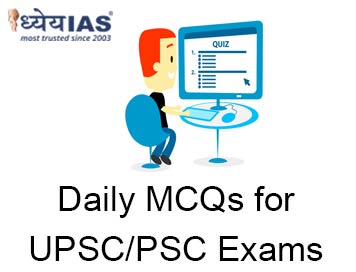Home > Daily-mcqs
Daily-mcqs 24 Nov 2025

Q1:
With reference to the Light Combat Aircraft (LCA) Tejas, consider the following statements: 1. Tejas is India’s first indigenously designed and produced 4.5-generation fighter aircraft. 2. It is developed by Hindustan Aeronautics Limited (HAL) in collaboration with the Aeronautical Development Agency (ADA). 3. Tejas has been certified as the world’s lightest supersonic fighter aircraft. Which of the statements given above is/are correct?
A: 1 and 2 only
B: 1 and 3 only
C: 2 and 3 only
D: 1, 2, and 3
Answer: A
Explanation:
Statement 1 is correct.
Tejas is a 4.5-generation, single-engine, multi-role fighter aircraft and India’s first indigenously designed & developed aircraft of this class.
Statement 2 is correct.
It is developed by Hindustan Aeronautics Limited (HAL) in collaboration with the Aeronautical Development Agency (ADA).
Statement 3 is incorrect.
Tejas is among the lightest supersonic fighters, but not officially certified as the world’s lightest.
Q2:
Tejas Mk-1A variant, recently inducted into the IAF, includes which of the following enhancements compared to Tejas Mk-1? 1. Active Electronically Scanned Array (AESA) Radar 2. Air-to-Air Refuelling Capability 3. Electronic Warfare (EW) Suite 4. Beyond-Visual-Range (BVR) advanced missiles Select the correct answer:
A: 1 and 2 only
B: 1,3 and 4 only
C: 1, 2 and 3 only
D: 1, 2, 3 and 4
Answer: D
Explanation:
Tejas Mk-1A includes major upgrades over the original Mk-1 version:
Active Electronically Scanned Array (AESA) Radar→ improved target detection and tracking
Integrated Electronic Warfare (EW) Suite→ better survivability
Beyond-Visual-Range (BVR) advanced missiles → long-range engagement
Air-to-air refuelling → extended range
Q3:
With reference to the four labour codes notified by the Indian government on 21 November 2025, which of the following codes have been implemented? 1. Code on Wages, 2019 2. Code on Social Security, 2020 3. Industrial Relations Code, 2020 4. Occupational Safety, Health and Working Conditions Code, 2020 5. Code on Building & Construction Workers, 2023 Select the correct answer:
A: 1, 3,4 and 5 only
B: 1,2, 3 and 5 only
C: 2 ,3 ,4 and 5 only
D: 1, 2, 3 and 4 Only
Answer: D
Explanation:
The four labour codes notified as of 21 November 2025 are:
There is no Code on Building & Construction Workers, 2023 in this list
Q4:
Which of the following is/are key features of the new labour codes notified on 21 November 2025? 1. A national floor wage has been introduced. 2. Fixed-term workers will now be eligible for gratuity after one year of continuous service. 3. The threshold for requiring government approval for lay-offs/retrenchment is now 300 workers. 4. All workers above the age of 40 must be given free annual medical check-ups. Select the correct answer:
A: 1 and 2 only
B: 1,3 and 4 only
C: 1, 2 and 3 only
D: 1, 2, 3 and 4
Answer: D
Explanation:
Statement 1 is correct.
National floor wage: — the new codes standardize the definition of “wages” and also provide for a national floor wage to reduce disparity.
Statement 2 is correct.
Fixed-term workers’ gratuity: Fixed-term employment is formally recognised, and these employees become eligible for gratuity after one year.
Statement 3 is correct.
Lay-off threshold: The industrial relations code raises the mandatory government-approval threshold for layoffs (or retrenchment) from 100 to 300 workers.
Statement 4 is correct.
Annual medical check-ups: Under the OSHWC code, there is a provision for free annual health check-ups for workers above a certain age.
Q5:
Which of the following are correct statements regarding the UPI–TIPS linking process? 1. The ECB Governing Council has approved starting the “realisation phase” of the UPI–TIPS link. 2. NPCI International Payments Ltd (NIPL) is partnering with ECB / Eurosystem to operationalize this link. 3. The interlinking directly enables cross-currency conversions between Indian rupee and euro within TIPS. Select the correct answer:
A: 1 and 2 only
B: 2 only
C: 2 and 3 only
D: 1, 2, and 3
Answer: A
Explanation:
Statement 1 is correct: ECB has moved to the “realisation phase” for interlinking TIPS with UPI.
Statement 2 is correct: RBI and NIPL (NPCI’s international arm) are working with the ECB on “technical integration, risk management, and settlement arrangements.”
Statement 3 is incorrect: While ECB has a roadmap for cross-currency settlement on TIPS, the UPI–TIPS link is primarily about a payments corridor, not about immediate cross-currency conversion between INR and EUR inside TIPS.
Q6:
1. UPI is built on the Immediate Payment Service (IMPS) platform. 2. UPI is regulated by the RBI and operated by the National Payments Corporation of India (NPCI). 3. UPI allows peer-to-peer as well as peer-to-merchant payments. Which of the above statements are correct?Consider the following statements regarding Unified Payments Interface (UPI):
A: 1 and 2 only
B: 1 and 3 only
C: 2 and 3 only
D: 1, 2, and 3
Answer: D
Explanation:
Statement 1 – Correct: UPI leverages IMPS infrastructure for real-time fund transfers.
Statement 2 – Correct: UPI is designed by NPCI, a not-for-profit entity under RBI’s regulation.
Statement 3 – Correct: UPI supports P2P, P2M, recurring payments, autopay, QR payments, etc.